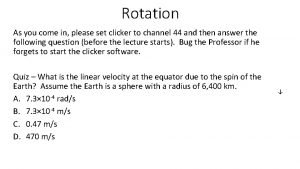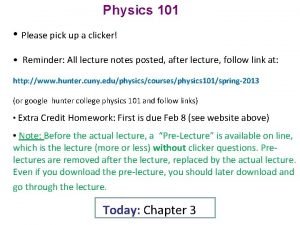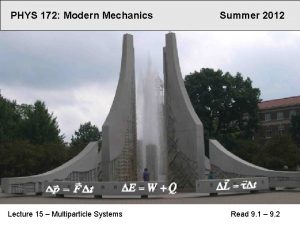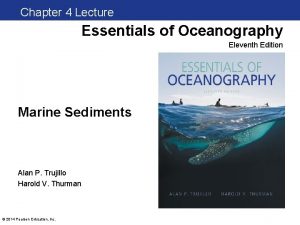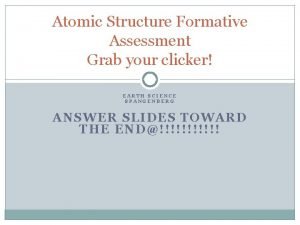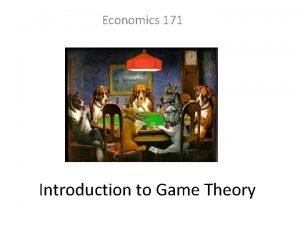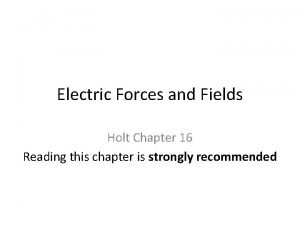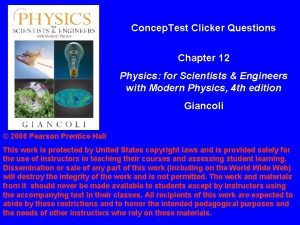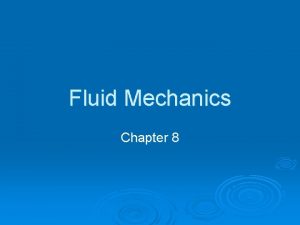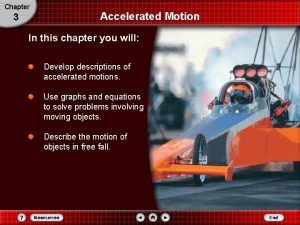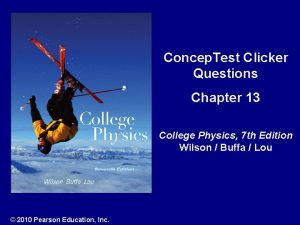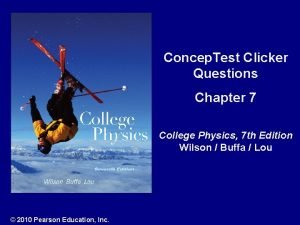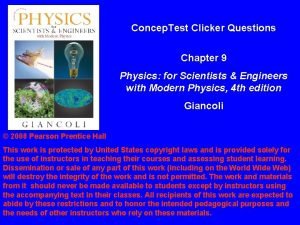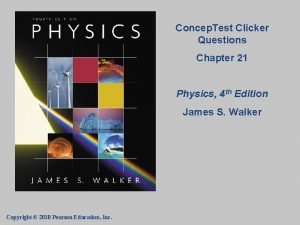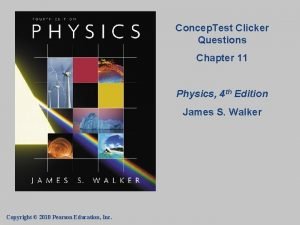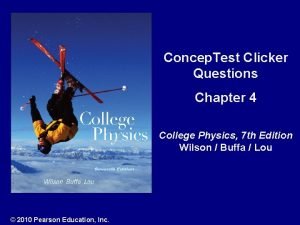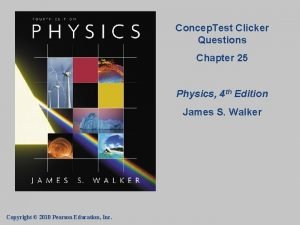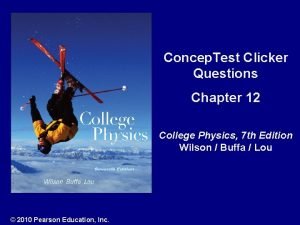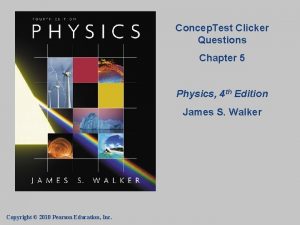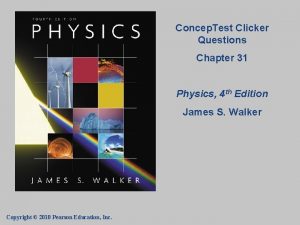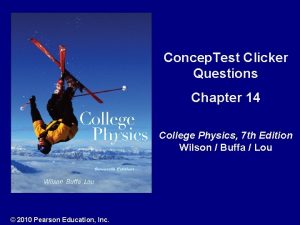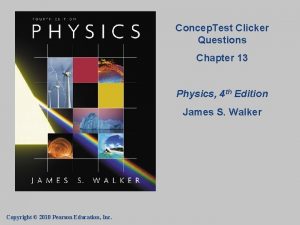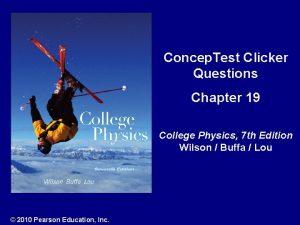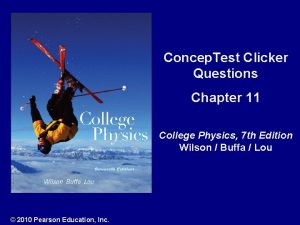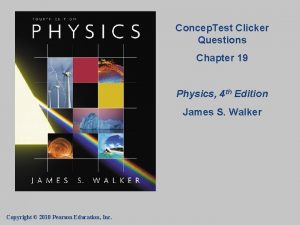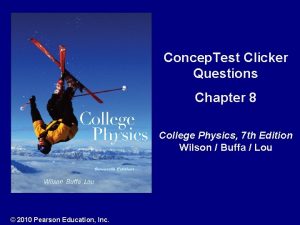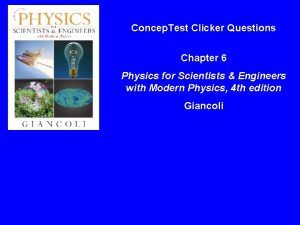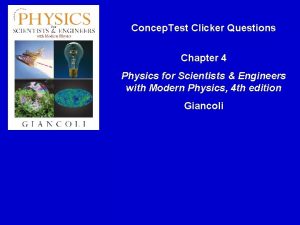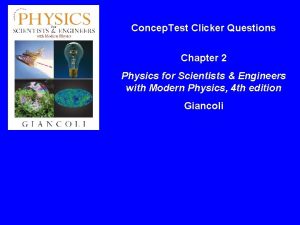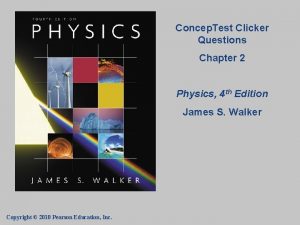Concep Test Clicker Questions Chapter 14 Physics for













































- Slides: 45

Concep. Test Clicker Questions Chapter 14 Physics for Scientists & Engineers with Modern Physics, 4 th edition Giancoli © 2009 Pearson Education, Inc. This work is protected by United States copyright laws and is provided solely for the use of instructors in teaching their courses and assessing student learning. Dissemination or sale of any part of this work (including on the World Wide Web) will destroy the integrity of the work and is not permitted. The work and materials from it should never be made available to students except by instructors using the accompanying text in their classes. All recipients of this work are expected to abide by these restrictions and to honor the intended pedagogical purposes and the needs of other instructors who rely on these materials.

Concep. Test 14. 1 a Harmonic Motion I A mass on a spring in SHM has 1) 0 amplitude A and period T. What 2) A/2 is the total distance traveled by 3) A the mass after a time interval T? 4) 2 A 5) 4 A

Concep. Test 14. 1 a Harmonic Motion I A mass on a spring in SHM has 1) 0 amplitude A and period T. What 2) A/2 is the total distance traveled by 3) A the mass after a time interval T? 4) 2 A 5) 4 A In the time interval T (the period), the mass goes through one complete oscillation back to the starting point. The distance it covers is A + A + A (4 A).

Concep. Test 14. 1 b Harmonic Motion II A mass on a spring in SHM has amplitude A and period T. What is the net displacement of the mass after a time interval T? 1) 0 2) A/2 3) A 4) 2 A 5) 4 A

Concep. Test 14. 1 b Harmonic Motion II A mass on a spring in SHM has amplitude A and period T. What is the net displacement of the mass after a time interval T? 1) 0 2) A/2 3) A 4) 2 A 5) 4 A The displacement is Dx = x 2 – x 1. Because the initial and final positions of the mass are the same (it ends up back at its original position), then the displacement is zero. Follow-up: What is the net displacement after a half of a period?

Concep. Test 14. 1 c Harmonic Motion III A mass on a spring in SHM has amplitude A and period T. How long does it take for the mass to travel a total distance of 6 A ? 1) T 2) T 3) 1 T 4) 1 T 5) 2 T

Concep. Test 14. 1 c Harmonic Motion III A mass on a spring in SHM has amplitude A and period T. How long does it take for the mass to travel a total distance of 6 A ? 1) T 2) T 3) 1 T 4) 1 T 5) 2 T We have already seen that it takes one period T to travel a total distance of 4 A. An additional 2 A requires half a period, so the total time needed for a total distance of 6 A is 1 T. Follow-up: What is the net displacement at this particular time?

Concep. Test 14. 2 Speed and Acceleration A mass on a spring in SHM has 1) x = A amplitude A and period T. At 2) x > 0 but x < A what point in the motion is v = 0 3) x = 0 and a = 0 simultaneously? 4) x < 0 5) none of the above

Concep. Test 14. 2 Speed and Acceleration A mass on a spring in SHM has 1) x = A amplitude A and period T. At 2) x > 0 but x < A what point in the motion is v = 0 3) x = 0 and a = 0 simultaneously? 4) x < 0 5) none of the above If both v and a were zero at the same time, the mass would be at rest and stay at rest! Thus, there is NO point at which both v and a are both zero at the same time. Follow-up: Where is acceleration a maximum?

Concep. Test 14. 3 a Spring Combination I A spring can be stretched a distance of 60 cm with an applied force of 1 N. If an identical spring is connected in parallel with the first spring, and both are pulled together, how much force will be required to stretch this parallel combination a distance of 60 cm? 1) N 2) N 3) 1 N 4) 2 N 5) 4 N

Concep. Test 14. 3 a Spring Combination I A spring can be stretched a distance of 60 cm with an applied force of 1 N. If an identical spring is connected in parallel with the first spring, and both are pulled together, how much force will be required to stretch this parallel combination a distance of 60 cm? 1) N 2) N 3) 1 N 4) 2 N 5) 4 N Each spring is still stretched 60 cm, so each spring requires 1 N of force. But because there are two springs, there must be a total of 2 N of force! Thus, the combination of two parallel springs behaves like a stronger spring!!

Concep. Test 14. 3 b Spring Combination II A spring can be stretched a distance of 60 cm with an applied force of 1 N. If an identical spring is connected in series with the first spring, how much force will be required to stretch this series combination a distance of 60 cm? 1) N 2) N 3) 1 N 4) 2 N 5) 4 N

Concep. Test 14. 3 b Spring Combination II A spring can be stretched a distance of 60 cm with an applied force of 1 N. If an identical spring is connected in series with the first spring, how much force will be required to stretch this series combination a distance of 60 cm? 1) N 2) N 3) 1 N 4) 2 N 5) 4 N Here, the springs are in series, so each spring is only stretched 30 cm, and only half the force is needed. But also, because the springs are in a row, the force applied to one spring is transmitted to the other spring (like tension in a rope). So the overall applied force of N is all that is needed. The combination of two springs in series behaves like a weaker spring!!

Concep. Test 14. 4 To the Center of the Earth A hole is drilled through the 1) you fall to the center and stop center of Earth and emerges on the other side. You jump into the hole. What happens 2) you go all the way through and continue off into space to you ? 3) you fall to the other side of Earth and then return 4) you won’t fall at all

Concep. Test 14. 4 To the Center of the Earth A hole is drilled through the center of Earth and emerges on the other side. You jump into the hole. What happens to you ? 1) you fall to the center and stop 2) you go all the way through and continue off into space 3) you fall to the other side of Earth and then return 4) you won’t fall at all You fall through the hole. When you reach the center, you keep going because of your inertia. When you reach the other side, gravity pulls you back toward the center This is Simple Harmonic Motion! Follow-up: Where is your acceleration zero?

Concep. Test 14. 5 a Energy in SHM I A mass oscillates in simple harmonic motion with amplitude A. If the mass is doubled, but the amplitude is not changed, what will happen to the total energy of the system? 1) total energy will increase 2) total energy will not change 3) total energy will decrease

Concep. Test 14. 5 a Energy in SHM I A mass oscillates in simple harmonic motion with amplitude A. If the mass is doubled, but the amplitude is not changed, what will happen to the total energy of the system? 1) total energy will increase 2) total energy will not change 3) total energy will decrease The total energy is equal to the initial value of the elastic potential energy, which is PEs = k. A 2. This does not depend on mass, so a change in mass will not affect the energy of the system. Follow-up: What happens if you double the amplitude?

Concep. Test 14. 5 b Energy in SHM II If the amplitude of a simple 1) frequency harmonic oscillator is doubled, 2) period which of the following quantities 3) maximum speed will change the most? 4) maximum acceleration 5) total mechanical energy

Concep. Test 14. 5 b Energy in SHM II If the amplitude of a simple 1) frequency harmonic oscillator is doubled, 2) period which of the following quantities 3) maximum speed will change the most? 4) maximum acceleration 5) total mechanical energy Frequency and period do not depend on amplitude at all, so they will not change. Maximum acceleration and maximum speed do depend on amplitude, and both of these quantities will double. (You should think about why this is so. ) The total energy equals the initial potential energy, which depends on the square of the amplitude, so that will quadruple. Follow-up: Why do maximum acceleration and speed double?

Concep. Test 14. 6 a Period of a Spring I A glider with a spring attached to each end oscillates with a certain period. If the mass of the glider is doubled, what will happen to the period? 1) period will increase 2) period will not change 3) period will decrease

Concep. Test 14. 6 a Period of a Spring I A glider with a spring attached to each end oscillates with a certain period. If the mass of the glider is doubled, what will happen to the period? 1) period will increase 2) period will not change 3) period will decrease The period is proportional to the square root of the mass. So an increase in mass will lead to an increase in the period of motion. m T = 2 p k Follow-up: What happens if the amplitude is doubled?

Concep. Test 14. 6 b Period of a Spring II A glider with a spring attached to each end oscillates with a certain period. If identical springs are added in parallel to the original glider, what will happen to the period? 1) period will increase 2) period will not change 3) period will decrease

Concep. Test 14. 6 b Period of a Spring II A glider with a spring attached to each end oscillates with a certain period. If identical springs are added in parallel to the original glider, what will happen to the period? 1) period will increase 2) period will not change 3) period will decrease We saw in the last section that two springs in parallel act like a stronger spring. So the spring constant has been effectively increased, and the period is inversely proportional to the square root of the spring constant, which leads to a decrease in the period of motion. m T = 2 p k

Concep. Test 14. 7 a Spring in an Elevator I A mass is suspended from the ceiling of an elevator by a spring. When the elevator is at rest, the period is T. What happens to the period when the elevator is moving upward at constant speed? 1) period will increase 2) period will not change 3) period will decrease

Concep. Test 14. 7 a Spring in an Elevator I A mass is suspended from the ceiling of an elevator by a spring. When the elevator is at rest, the period is T. What happens to the period when the elevator is moving upward at constant speed? 1) period will increase 2) period will not change 3) period will decrease Nothing at all changes when the elevator moves at constant speed. The equilibrium elongation of the spring is the same, and the period of simple harmonic motion is the same.

Concep. Test 14. 7 b Spring in an Elevator II A mass is suspended from the ceiling of an elevator by a spring. When the elevator is at rest, the period is T. What happens to the period when the elevator is accelerating upward? 1) period will increase 2) period will not change 3) period will decrease

Concep. Test 14. 7 b Spring in an Elevator II A mass is suspended from the ceiling of an elevator by a spring. When the elevator is at rest, the period is T. What happens to the period when the elevator is accelerating upward? 1) period will increase 2) period will not change 3) period will decrease When the elevator accelerates upward, the hanging mass feels “heavier” and the spring will stretch a bit more. Thus, the equilibrium elongation of the spring will increase. However, the period of simple harmonic motion does not depend upon the elongation of the spring—it only depends on the mass and the spring constant, and neither one of them has changed.

Concep. Test 14. 7 c Spring on the Moon A mass oscillates on a vertical spring with period T. If the whole setup is taken to the Moon, how does the period change? 1) period will increase 2) period will not change 3) period will decrease

Concep. Test 14. 7 c Spring on the Moon A mass oscillates on a vertical spring with period T. If the whole setup is taken to the Moon, how does the period change? 1) period will increase 2) period will not change 3) period will decrease The period of simple harmonic motion depends only on the mass and the spring constant and does not depend on the acceleration due to gravity. By going to the Moon, the value of g has been reduced, but that does not affect the period of the oscillating mass–spring system. Follow-up: Will the period be the same on any planet?

Concep. Test 14. 8 a Period of a Pendulum I Two pendula have the same length, but different masses attached to the string. How do their periods compare? 1) period is greater for the greater mass 2) period is the same for both cases 3) period is greater for the smaller mass

Concep. Test 14. 8 a Period of a Pendulum I Two pendula have the same length, but different masses attached to the string. How do their periods compare? 1) period is greater for the greater mass 2) period is the same for both cases 3) period is greater for the smaller mass The period of a pendulum depends on the length and the acceleration due to gravity, but it does not depend on the mass of the bob. T = 2 p L g Follow-up: What happens if the amplitude is doubled?

Concep. Test 14. 8 b Period of a Pendulum II Two pendula have different lengths: one has length L and the other has length 4 L. How do their periods compare? 1) period of 4 L is four times that of L 2) period of 4 L is two times that of L 3) period of 4 L is the same as that of L 4) period of 4 L is one-half that of L 5) period of 4 L is one-quarter that of L

Concep. Test 14. 8 b Period of a Pendulum II Two pendula have different lengths: one has length L and the other has length 4 L. How do their periods compare? 1) period of 4 L is four times that of L 2) period of 4 L is two times that of L 3) period of 4 L is the same as that of L 4) period of 4 L is one-half that of L 5) period of 4 L is one-quarter that of L The period of a pendulum depends on the length and the acceleration due to gravity. The length dependence goes as the square root of L, so a pendulum four times longer will have a period that is two times larger. T = 2 p L g

Concep. Test 14. 9 Grandfather Clock A grandfather clock has a weight at the bottom of the pendulum that can be moved up or down. If the clock is running slow, what should you do to adjust the time properly? 1) move the weight up 2) move the weight down 3) moving the weight will not matter 4) call the repairman

Concep. Test 14. 9 Grandfather Clock A grandfather clock has a weight at the bottom of the pendulum that can be moved up or down. If the clock is running slow, what should you do to adjust the time properly? 1) move the weight up 2) move the weight down 3) moving the weight will not matter 4) call the repairman The period of the grandfather clock is too long, so we need to decrease the period (increase the frequency). To do this, the length must be decreased, so the adjustable weight should be moved up in order to shorten the pendulum length. L T = 2 p g

Concep. Test 14. 10 a Pendulum in Elevator I A pendulum is suspended from the ceiling of an elevator. When the elevator is at rest, the period is T. What happens to the period when the elevator is moving upward at constant speed? 1) period will increase 2) period will not change 3) period will decrease

Concep. Test 14. 10 a Pendulum in Elevator I A pendulum is suspended from the ceiling of an elevator. When the elevator is at rest, the period is T. What happens to the period when the elevator is moving upward at constant speed? 1) period will increase 2) period will not change 3) period will decrease Nothing changes when the elevator moves at constant speed. Neither the length nor the effective value of g has changed, so the period of the pendulum is the same.

Concep. Test 14. 10 b Pendulum in Elevator II A pendulum is suspended from the ceiling of an elevator. When the elevator is at rest, the period is T. What happens to the period when the elevator is accelerating upward? 1) period will increase 2) period will not change 3) period will decrease

Concep. Test 14. 10 b Pendulum in Elevator II A pendulum is suspended from the ceiling of an elevator. When the elevator is at rest, the period is T. What happens to the period when the elevator is accelerating upward? 1) period will increase 2) period will not change 3) period will decrease When the elevator accelerates upward, the hanging mass feels “heavier”—this means that the effective value of g has increased due to the acceleration of the elevator. Because the period depends inversely on g, and the effective value of g increased, then the period of the pendulum will decrease (i. e. , its frequency will increase and it will swing faster).

Concep. Test 14. 10 c Pendulum in Elevator III A swinging pendulum has period T on Earth. If the same pendulum 1) period increases were moved to the Moon, how 2) period does not change does the new period compare to 3) period decreases the old period?

Concep. Test 14. 10 c Pendulum in Elevator III A swinging pendulum has period T on Earth. If the same pendulum 1) period increases were moved to the Moon, how 2) period does not change does the new period compare to 3) period decreases the old period? The acceleration due to gravity is smaller on the Moon. The relationship between the period and g is given by: L T = 2 p g therefore, if g gets smaller, T will increase Follow-up: What can you do to return the pendulum to its original period?

Concep. Test 14. 11 Damped Pendulum After a pendulum starts swinging, its amplitude gradually decreases with time because of friction. 1) period increases What happens to the period of the 3) period decreases pendulum during this time ? 2) period does not change

Concep. Test 14. 11 Damped Pendulum After a pendulum starts swinging, its amplitude gradually decreases with time because of friction. 1) period increases What happens to the period of the 3) period decreases 2) period does not change pendulum during this time ? The period of a pendulum does not depend on its amplitude, amplitude but only on its length and the acceleration due to gravity T = 2 p L g Follow-up: What is happening to the energy of the pendulum?

Concep. Test 14. 12 Swinging in the Rain You are sitting on a swing. A friend gives you a push, and you start swinging with period T 1. Suppose you were standing on the swing rather than sitting. When given the same push, you start swinging with period T 2. Which of the following is true? 1) T 1 = T 2 2) T 1 > T 2 3) T 1 < T 2 T 1

Concep. Test 14. 12 Swinging in the Rain You are sitting on a swing. A friend gives you a push, and you start swinging with period T 1. Suppose you were standing on the swing rather than sitting. When given the same push, you start swinging with period T 2. Which of the following is true? Standing up raises the Center of Mass of the swing, making it shorter !! Because L 1 > L 2 , then T 1 > T 2. T = 2 p L g 1) T 1 = T 2 2) T 1 > T 2 3) T 1 < T 2 L 1 T 2
 Clicker questions physics
Clicker questions physics Paano gumawa ng concept map
Paano gumawa ng concept map Mathclicker
Mathclicker E clicker
E clicker Turning point audience response system
Turning point audience response system Lesson 5 building an app clicker game
Lesson 5 building an app clicker game Earth clicker
Earth clicker Maximal heart rate
Maximal heart rate Japan movie rape
Japan movie rape Clicker stop motion
Clicker stop motion Cooi clicker
Cooi clicker Umbc clicker
Umbc clicker Clicker box
Clicker box Youtube youtube
Youtube youtube Clicker stop motion
Clicker stop motion Clicker
Clicker Particl clicker
Particl clicker Hlyniany
Hlyniany Salt clicker
Salt clicker Clicker gravel transport
Clicker gravel transport Atomic clicker
Atomic clicker Spacebar click
Spacebar click Fibonacci clicker
Fibonacci clicker Clicker
Clicker Presentation clicker challenger
Presentation clicker challenger Cosine rule bbc
Cosine rule bbc Atomic clicker
Atomic clicker Evolutionary history
Evolutionary history Direction of dipole moment
Direction of dipole moment Chapter 12 physics test
Chapter 12 physics test Chapter 8 fluid mechanics
Chapter 8 fluid mechanics Chapter 2 representing motion assessment answers
Chapter 2 representing motion assessment answers What is the difference between velocity and acceleration
What is the difference between velocity and acceleration Modern physics vs classical physics
Modern physics vs classical physics University physics with modern physics fifteenth edition
University physics with modern physics fifteenth edition Physics ia introduction
Physics ia introduction Kontinuitetshantering
Kontinuitetshantering Novell typiska drag
Novell typiska drag Tack för att ni lyssnade bild
Tack för att ni lyssnade bild Ekologiskt fotavtryck
Ekologiskt fotavtryck Varför kallas perioden 1918-1939 för mellankrigstiden?
Varför kallas perioden 1918-1939 för mellankrigstiden? En lathund för arbete med kontinuitetshantering
En lathund för arbete med kontinuitetshantering Kassaregister ideell förening
Kassaregister ideell förening Tidböcker
Tidböcker Sura för anatom
Sura för anatom Förklara densitet för barn
Förklara densitet för barn











